
Geotechnique Letters
Scope & Guideline
Exploring the Depths of Geotechnical Research.
Introduction
Aims and Scopes
- Geotechnical Behavior of Soils:
Research focused on the mechanical and physical properties of soils, including studies on shear strength, compressibility, permeability, and the effects of saturation and loading conditions. - Innovative Materials and Techniques:
Exploration of novel materials such as bio-cements, polymers, and waste materials like fly ash for soil improvement and stabilization, highlighting sustainable practices in geotechnics. - Advanced Modelling and Simulation:
Utilization of sophisticated computational methods such as finite element analysis, discrete element modeling, and topic modeling to predict soil behavior and optimize geotechnical designs. - Field and Laboratory Testing:
Emphasis on experimental research that includes both field tests and laboratory analyses to validate theoretical models and enhance practical applications in geotechnical engineering. - Interdisciplinary Approaches:
Integration of concepts from related fields such as microbiology, material science, and environmental engineering to address complex geotechnical challenges.
Trending and Emerging
- Sustainable Geotechnical Practices:
A significant rise in studies focusing on sustainable practices, such as the use of biopolymers and microbial processes for soil improvement, underscores a growing awareness of environmental impacts. - 3D Printing and Advanced Fabrication Techniques:
Research investigating the use of 3D printing technologies in geotechnical applications indicates a trend towards innovative construction methods and materials, enhancing design flexibility and efficiency. - Microstructural Analysis Techniques:
There is an increasing emphasis on the use of advanced imaging techniques like X-ray microtomography to study soil microstructure, providing deeper insights into soil behavior under various conditions. - Interfacial Behavior and Material Interaction:
Emerging research on the interaction between different materials, such as soil and synthetic surfaces, highlights the importance of interface properties in geotechnical engineering applications. - Cyclic and Dynamic Loading Effects:
An uptick in studies exploring the effects of cyclic loading and dynamic conditions on soil stability and behavior reflects the need for more resilient geotechnical designs in the face of natural hazards.
Declining or Waning
- Traditional Soil Mechanics:
There appears to be a waning interest in classical soil mechanics topics, such as basic consolidation and simple shear tests, as researchers increasingly explore more complex behaviors and modern materials. - Static Analysis of Foundations:
Research on static, deterministic analyses of foundation systems has declined, possibly due to a growing emphasis on dynamic analysis and the influence of environmental factors like seismic activity. - Basic Soil Classification Systems:
As new methodologies and technologies emerge, traditional soil classification systems are becoming less prominent, with researchers favoring more nuanced approaches that consider microstructural and behavioral aspects.
Similar Journals

COMPUTERS AND GEOTECHNICS
Exploring the Future of Geotechnics with Computational Insights.COMPUTERS AND GEOTECHNICS is a premier scholarly journal published by Elsevier Science Ltd, devoted to advancing the intersection of computer science and geotechnical engineering. With an impressive impact factor and categorically recognized as a Q1 journal in both Computer Science Applications and Geotechnical Engineering as of 2023, it stands at the forefront of research in its field. The journal has maintained a remarkable reputation since its inception in 1985, providing a dynamic platform for disseminating cutting-edge research, technological advancements, and innovative methodologies related to the application of computer science in geotechnics. Researchers, professionals, and students benefit from its rigorous peer-review process and high-quality publications, which demonstrate practical applications and theoretical foundations necessary for the relevant industries. Renowned for an extensive global readership, COMPUTERS AND GEOTECHNICS plays a critical role in fostering collaboration and development in tackling complex geotechnical challenges through computational methods, all while contributing to the broader understanding of environmental interactions. This journal provides essential insights and is instrumental for those at the cutting edge of this evolving discipline.

CANADIAN GEOTECHNICAL JOURNAL
Exploring Innovative Solutions in GeotechnicsCanadian Geotechnical Journal, published by Canadian Science Publishing, stands as a premier resource in the field of geotechnical engineering, focusing on the science and practice of soil mechanics, engineering geology, and related disciplines. Established in 1968, this esteemed journal has earned a distinguished reputation, holding a Q1 ranking in both Civil and Structural Engineering as well as Geotechnical Engineering and Engineering Geology as of 2023. It features a rigorous peer-review process that ensures the publication of high-quality research, making it essential reading for researchers, professionals, and students alike. With an impressive Scopus rank of #63 out of 379 in Civil and Structural Engineering and #41 out of 229 in Geotechnical Engineering, the journal continues to contribute significantly to the advancement of knowledge in geotechnics. While the journal does not currently provide open access options, it remains a vital platform for disseminating innovative findings and fostering academic collaboration in the geotechnical community.

Transportation Infrastructure Geotechnology
Exploring the Nexus of Geotechnology and Civil Engineering.Transportation Infrastructure Geotechnology, an esteemed journal published by SpringerNature, serves as a vital platform in the fields of Civil and Structural Engineering, Environmental Engineering, Geotechnical Engineering, and Transportation. Established in 2014 and spanning a decade of significant scientific discourse, this journal has gained recognition for its robust contribution to the understanding of the interplay between geotechnical processes and transportation infrastructure. With an impactful Q2 ranking in multiple categories—including Civil and Structural Engineering and Environmental Engineering—it emphasizes innovative research and practical applications globally. Researchers and professionals can explore critical topics that influence infrastructure sustainability, safety, and efficiency. Although it operates under a subscription model, its affiliation with SpringerNature ensures rigorous peer-review and high-quality publications, making it an indispensable resource for academics and industry experts alike.
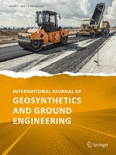
International Journal of Geosynthetics and Ground Engineering
Elevating the standards of geosynthetic technology and engineering practices.International Journal of Geosynthetics and Ground Engineering, published by SPRINGER INT PUBL AG, stands as a vital resource for the fields of civil engineering and materials science, particularly in the study and application of geosynthetics. With an ISSN of 2199-9260 and E-ISSN 2199-9279, this journal has established itself in the academic community, achieving a commendable position in Q2 category rankings for both Civil and Structural Engineering and Polymers and Plastics as of 2023. It ranks 134th in civil engineering and 77th in polymer science within Scopus, reflecting a respectable impact factor that emphasizes its influence in these disciplines. The journal covers a diverse range of topics, from innovative geosynthetic materials to groundbreaking engineering applications, and aims to foster an environment of collaboration and knowledge dissemination among researchers, professionals, and students. With its scope extending from 2015 to 2024, the International Journal of Geosynthetics and Ground Engineering is committed to pushing the boundaries of research and development in sustainable engineering practices, making it an essential publication for those interested in the future of geosynthetic technology.

Indian Geotechnical Journal
Connecting Scholars and Practitioners in Ground Engineering.Indian Geotechnical Journal, published by SPRINGER INDIA, is a premier publication dedicated to the cutting-edge field of geotechnical engineering and engineering geology. With an ISSN of 0971-9555 and an E-ISSN of 2277-3347, this journal serves as a pivotal platform for researchers, professionals, and students seeking to share innovative research and insights that contribute significantly to the development of the discipline. Recognized for its high-quality content, the journal holds a Q2 ranking in the Geotechnical Engineering and Engineering Geology category as of 2023, reflecting its influence and relevance in the academic community. Spanning contributions from 1972 to 1989 and resuming during 2012 to 2024, it showcases a historical depth coupled with contemporary research trends. Despite being a subscription-based journal, the quality of its articles ensures a broad readership, fostering collaboration and knowledge exchange among geotechnical professionals globally. Positioned at the intersection of theory and practice, the Indian Geotechnical Journal aims to advance understanding, encourage innovation, and address the pressing challenges faced in geotechnical engineering today.
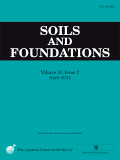
Soils and Foundations
Connecting researchers and practitioners in geotechnical advancements.Soils and Foundations, an esteemed journal published by the Japanese Geotechnical Society, has established itself as a pivotal platform for innovative research in Civil and Structural Engineering and Geotechnical Engineering. With an impressive impact factor reflected in its Q1 quartile ratings for both disciplines, the journal provides critical insights that foster advancements in the understanding of soil behavior and foundation design. Since its transition to Open Access in 2020, Soils and Foundations has broadened its reach, ensuring accessible dissemination of knowledge to researchers, students, and professionals globally. With a rich history dating back to its inception in 1960, the journal continues to uphold a high standard of scholarly excellence, ranking within the top percentile in Scopus across geotechnical engineering fields. This commitment to quality and accessibility makes it an essential resource for anyone engaged in the vital areas of soil mechanics and foundation engineering.
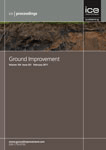
Proceedings of the Institution of Civil Engineers-Ground Improvement
Fostering Collaboration in Civil Engineering ExcellenceProceedings of the Institution of Civil Engineers-Ground Improvement is a distinguished journal published by EMERALD GROUP PUBLISHING LTD, dedicated to advancing knowledge and research in the fields of Building and Construction, Geotechnical Engineering, Mechanics of Materials, and Soil Science. With an ISSN of 1755-0750 and an E-ISSN of 1755-0769, this journal has been a vital platform for disseminating innovative research since its inception in 2008. With an impact factor placing it in the Q3 category across multiple engineering disciplines, it ranks favorably in Scopus, ensuring visibility and recognition among scholars globally. The journal offers open access options, allowing for broader dissemination of research findings. Targeting researchers, professionals, and students alike, it aims to foster discussions on ground improvement technologies and methodologies that are essential for sustainable infrastructure development. As it continues to converge its focus until 2024, the Proceedings stands as an imperative resource for those seeking to elevate their understanding and contribute to the ever-evolving field of civil engineering.

Jordan Journal of Civil Engineering
Innovative Research for Tomorrow's InfrastructureThe Jordan Journal of Civil Engineering, ISSN 1993-0461 and E-ISSN 2225-157X, serves as a pivotal platform for research dissemination in the field of civil engineering. Published by Jordan University of Science & Technology, this journal has established itself as a vital resource since its inception in 2007 and continues to impact the academic community with its wide-ranging scope covering innovative practices and cutting-edge research in civil and structural engineering. Holding a respectable Q3 ranking in the 2023 category, with Scopus positioning it at rank #235 out of 379, the journal reflects growing recognition within its discipline. Although currently not an open-access publication, it provides essential insights that can benefit researchers, industry professionals, and students seeking to contribute to advancements in civil engineering through rigorous scholarly articles and studies up to 2024. Its commitment to high academic standards enhances the relevance and importance of its contributions to both local and global engineering practices.
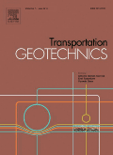
Transportation Geotechnics
Transforming Transportation Through Geotechnical Excellence.Transportation Geotechnics is a premier academic journal published by Elsevier, focusing on the intersection of geotechnical engineering and transportation systems. With an impressive impact factor and categorized in the Q1 quartile across multiple disciplines including Civil and Structural Engineering, Geotechnical Engineering, and Transportation, this journal stands as a vital resource for researchers and practitioners alike. It covers a broad spectrum of topics ranging from soil behavior in transport contexts to innovative materials and methods that enhance infrastructure stability and performance. As an essential platform fostering knowledge dissemination, Transportation Geotechnics enables contributors to share their groundbreaking findings while providing readers with access to cutting-edge research and reviews from 2014 to 2024. Its illustrious Scopus rankings place it prominently in the global research landscape, making it an indispensable tool for students, professionals, and academics dedicated to advancing the field.
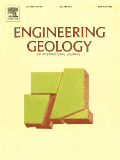
ENGINEERING GEOLOGY
Transforming Geological Principles into Engineering PracticesENGINEERING GEOLOGY, published by Elsevier, is a leading journal in the fields of Geology and Geotechnical Engineering, recognized by its prestigious Q1 ranking in both categories for 2023. With a deep focus on the application of geological principles to engineering practices, this journal plays a vital role in advancing knowledge and methodologies that enhance infrastructure development and environmental sustainability. Operating since 1965, the journal disseminates high-quality research, offering insights that foster innovation in geotechnical assessments and geological hazard evaluation. Researchers and professionals benefit from its rigorous peer-review process and impactful studies, bolstered by a strong Scopus ranking - #4 in Geology and #3 in Geotechnical Engineering, both placing it in the top 2% of its field. Although there is no Open Access option available, the journal facilitates significant academic discourse, making it an essential resource for anyone involved in the intersection of geology and engineering.